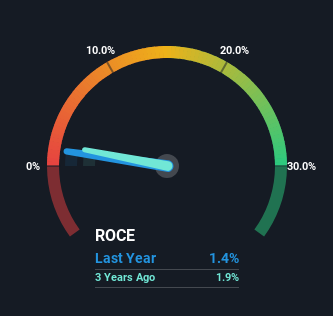Vallianz Holdings (Catalist:WPC) Could Be Struggling To Allocate Capital
When we're researching a company, it's sometimes hard to find the warning signs, but there are some financial metrics that can help spot trouble early. Businesses in decline often have two underlying trends, firstly, a declining return on capital employed (ROCE) and a declining base of capital employed. This indicates the company is producing less profit from its investments and its total assets are decreasing. Having said that, after a brief look, Vallianz Holdings (Catalist:WPC) we aren't filled with optimism, but let's investigate further.
Return On Capital Employed (ROCE): What Is It?
For those who don't know, ROCE is a measure of a company's yearly pre-tax profit (its return), relative to the capital employed in the business. To calculate this metric for Vallianz Holdings, this is the formula:
Return on Capital Employed = Earnings Before Interest and Tax (EBIT) ÷ (Total Assets - Current Liabilities)
0.014 = US$1.9m ÷ (US$268m - US$133m) (Based on the trailing twelve months to March 2023).
So, Vallianz Holdings has an ROCE of 1.4%. Ultimately, that's a low return and it under-performs the Energy Services industry average of 6.0%.
See our latest analysis for Vallianz Holdings
Historical performance is a great place to start when researching a stock so above you can see the gauge for Vallianz Holdings' ROCE against it's prior returns. If you're interested in investigating Vallianz Holdings' past further, check out this free graph of past earnings, revenue and cash flow.
The Trend Of ROCE
The trend of returns that Vallianz Holdings is generating are raising some concerns. The company used to generate 7.5% on its capital five years ago but it has since fallen noticeably. On top of that, the business is utilizing 66% less capital within its operations. The combination of lower ROCE and less capital employed can indicate that a business is likely to be facing some competitive headwinds or seeing an erosion to its moat. Typically businesses that exhibit these characteristics aren't the ones that tend to multiply over the long term, because statistically speaking, they've already gone through the growth phase of their life cycle.
On a side note, Vallianz Holdings' current liabilities have increased over the last five years to 50% of total assets, effectively distorting the ROCE to some degree. Without this increase, it's likely that ROCE would be even lower than 1.4%. What this means is that in reality, a rather large portion of the business is being funded by the likes of the company's suppliers or short-term creditors, which can bring some risks of its own.
Our Take On Vallianz Holdings' ROCE
In short, lower returns and decreasing amounts capital employed in the business doesn't fill us with confidence. Unsurprisingly then, the stock has dived 89% over the last five years, so investors are recognizing these changes and don't like the company's prospects. Unless there is a shift to a more positive trajectory in these metrics, we would look elsewhere.
One final note, you should learn about the 3 warning signs we've spotted with Vallianz Holdings (including 2 which make us uncomfortable) .
While Vallianz Holdings isn't earning the highest return, check out this free list of companies that are earning high returns on equity with solid balance sheets.
Have feedback on this article? Concerned about the content? Get in touch with us directly. Alternatively, email editorial-team (at) simplywallst.com.
This article by Simply Wall St is general in nature. We provide commentary based on historical data and analyst forecasts only using an unbiased methodology and our articles are not intended to be financial advice. It does not constitute a recommendation to buy or sell any stock, and does not take account of your objectives, or your financial situation. We aim to bring you long-term focused analysis driven by fundamental data. Note that our analysis may not factor in the latest price-sensitive company announcements or qualitative material. Simply Wall St has no position in any stocks mentioned.

